In order to achieve Human Security, a preventive approach to reduce risks and preparedness to respond to potential threats are essential aspects. In the Philippines, where natural disasters occur frequently, JICA makes efforts to strengthen the capacity of not only the government, but also local communities and individuals of the country.
Strengthening risk management for disaster and climate change
Disaster prevention plans are being made and observation networks established at each level, from the national and local governments to specific river basins and more.
Develop disaster-resilient infrastructure!
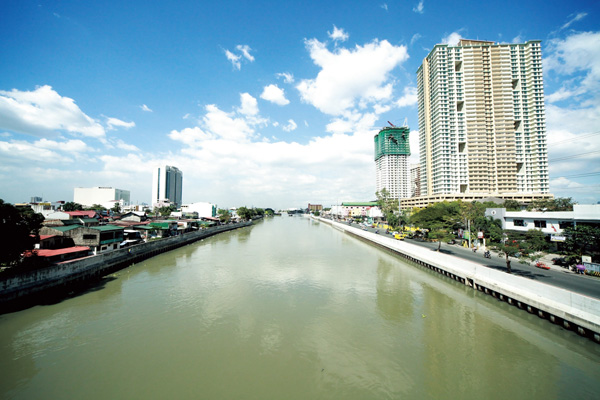
Embankments built along the Pasig and Marikina River to improve its flow.
Raising awareness on natural disasters
A total of 75 million people in the Philippines were affected by natural disasters between 2005 and 2014. In the recovery and reconstruction work following Typhoon Yolanda, which struck the Philippines in 2013, JICA promoted the "Build Back Better" approach. Based on the experiences of Japan--a country known for frequent natural disasters--is approach aims to construct a society that would be more resilient to disasters by preparing for the next disaster, this Build Back Better approach was reflected in the Philippines' reconstruction policies. The necessity of investment in prevention was repeatedly advocated based on the idea that a dollar invested in prevention can save four to seven dollars when a disaster strikes, and the Philippines government is starting to come around to this idea.
Moreover, in recent years, climate change has caused an increase in both the frequency and scale of natural disasters. Given the situation, JICA's continued cooperation intends to promote adaptation measures to climate change and contribute to protect human life, societies, and economies.
Holistic approach of "hard" and "soft" preparedness
The Pasig-Marikina River, which runs through the Philippine capital of Metro Manila, and the Manggahan Floodway, which branches off from it, are areas at high risk from natural disasters. More than 10,000 households live here in a vast slum. Each time the river system floods, the lives of these people are threatened.
Starting in 1990, and commencing with a master plan aimed to reduce flood damage in the Metro Manila, JICA has been cooperating simultaneously with both the "hard" aspects, the development of revetments and dredging along the Pasig and Marikina River, and the "soft" aspects, such as the creation of hazard maps, evacuation drills, and disaster prevention education for school pupils. "This project is noted for how it offers a holistic cooperation, covering everything from the planning stage to specific measures, and building on the assessment of the inundation risks based on scientific evidence.
"In this process, we are working to strengthen the disaster prevention capacities and human resource development for both the Philippines government and local authorities," noted MARUYAMA Kazuki from JICA's Global Environment Department. JICA is liaising with other organizations in order to fulfill the flood control master plan in the Metro Manila, and the World Bank is providing support for flood management measures in the upper stream of the Pasig-Marikina River.
"Aside from the projects in Metro Manila, we also focus on awareness-raising activities for the public," says HAYASHI Kimiko of the JICA Philippines office. One such project is the events and classes for disaster prevention conducted by Japanese experts and Japan Overseas Cooperation Volunteers (JOCVs) in schools around the country in collaboration with the Philippine Atmospheric, Geophysical and Astronomical Services Administration (PAGASA).
"In the Great Hanshin-Awaji Earthquake of 1995, about 70% of the people who were trapped or buried alive immediately after the earthquake were rescued by ‘self-help', including the help received from their families. It is important to focus on each individual and to obtain the right knowledge to protect ourselves and those close to us," says SAHEKI Takeshi, JICA Southeast Asia and Pacific Department.
Introducing risk assessment based on scientific evidence
Collecting and analyzing data related to natural disasters and climate change, predicting the effects of climate change, and improving weather forecasting.
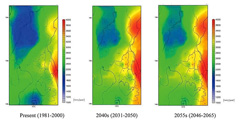
Data showing the annual rainfall distribution in mm/year in the Metro Manila and surrounding regions at present (1981-2000), in the climate of 2040 (2031-2050), and the climate of 2055 (2046-2065).
Source: Basic Information-Collection Survey on Water Resource Development Plans in Metro Manila and Surrounding Areas in the Philippines (Water Balance Analysis).
Measures from both the "hard" and "soft" aspects
River protection and other structural measures (hard) and, in parallel, strengthening the maintenance capacities of facilities and providing disaster prevention education (soft).
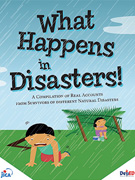
Disaster Prevention Handbook aimed at children, created in conjunction with the Ministry of Education and distributed nationwide.
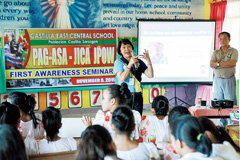
Let's learn about preventing disasters!
Training human resources and strengthening technical capacity
Strengthening the administrative capacity of the government and local authorities, and passing on the latest construction techniques and digital technologies.
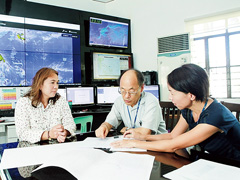
Preparing as a country
When a country's finances are heavily unbalanced due to a natural disaster, recovery will be greatly delayed. On September 15, 2020, the Philippines government signed the Post-Disaster Standby Loan (Phase 2), a facility that allows it to drawdown funds from JICA promptly and at low interest rates when a disaster happens. In Phase 1, from 2014, the Philippines borrowed a total of 50 billion yen, which was used to recover from Typhoon Yolanda and contributed to getting the people's lives back to normal quickly. One big difference with Phase 1 is that the loan can be applied to infectious diseases in addition to natural disasters, allowing responses to a greater range of threats.
JICA will continue to stand with the Philippines as it builds a society resilient to the threats of disasters and climate change through preventive approach and preparedness from the individuals to the national level.




scroll